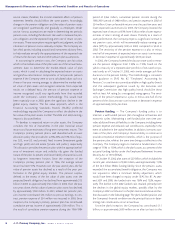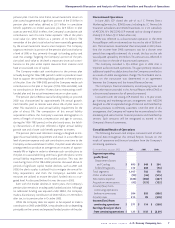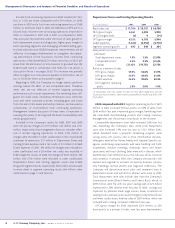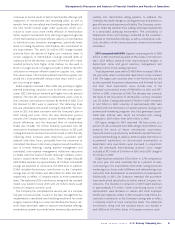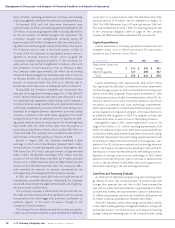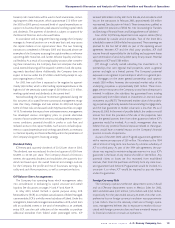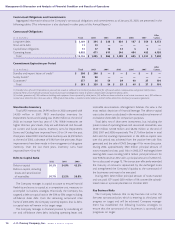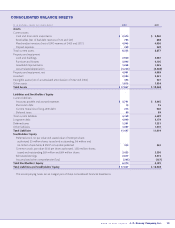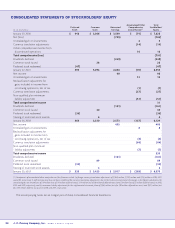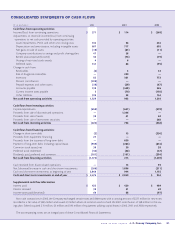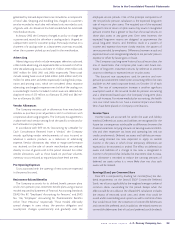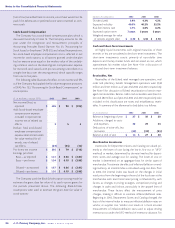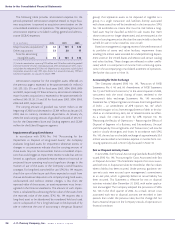JCPenney 2002 Annual Report Download - page 19
Download and view the complete annual report
Please find page 19 of the 2002 JCPenney annual report below. You can navigate through the pages in the report by either clicking on the pages listed below, or by using the keyword search tool below to find specific information within the annual report.
J. C. Penney Company, Inc. 2002 annual report16
Management’s Discussion and Analysis of Financial Condition and Results of Operations
Vendor,“ becomes effective for the Company in fiscal 2003. The
consensus reached on this issue was that cash consideration
received from a vendor is presumed to be a reduction of the cost
of merchandise and should be recorded as a reduction of cost of
goods sold unless the consideration is for either (1) payment for
assets or services and therefore revenue, or (2) a reimbursement of
costs incurred to sell the vendor’s products, and therefore, a reduc-
tion of advertising expense. The Company’s current accounting for
funds received from vendors is consistent with that proposed
under EITF 02-16; therefore, this issue will not have a material effect
on the Company’s consolidated financial statements.
In November 2002, the FASB issued FASB Interpretation No. 45
(FIN 45), “Guarantor’s Accounting and Disclosure Requirements for
Guarantees, Including Guarantees of Indebtedness of Others.”
Disclosures related to this interpretation are effective for 2002 annual
reports, and the accounting requirements are effective for guarantees
entered into or modified after December 31, 2002, and require all
guarantees and indemnifications within its scope to be recorded at
fair value as liabilities, and the maximum possible loss to the
Company under these guarantees and indemnifications to be dis-
closed. Current year disclosures related to guarantees are included on
pages 13-14 and in Note 19. Adoption of FIN 45 did not have a mate-
rial impact on the Company’s consolidated financial statements.
In December 2002, the FASB issued SFAS No. 148, “Accounting
for Stock-Based Compensation Costs – Transition and Disclosure.”
This statement amends SFAS No. 123, “Accounting for Stock-Based
Compensation,” and provides alternative methods of transition for
an entity that voluntarily changes to the fair value-based method of
accounting for stock-based compensation. It also requires addition-
al disclosures about the effects on reported net income of an enti-
ty’s accounting policy with respect to stock-based employee com-
pensation. As discussed under the accounting for stock options on
page 15, the Company accounts for stock-based compensation in
accordance with APB 25, and has adopted the disclosure-only alter-
native of SFAS No. 123. The Company adopted the disclosure pro-
visions of SFAS No. 148 for fiscal 2002. See Note 1 on page 24.
On January 17, 2003, FIN 46, “Consolidation of Variable Interest
Entities, an interpretation of ARB 51,” was issued. The primary
objective of FIN 46 is to provide guidance on the identification
and consolidation of variable interest entities, or VIEs, which are
entities for which control is achieved through means other than
through voting rights. The provisions of FIN 46 are required to be
adopted by the Company in fiscal 2003. The Company does not
expect the adoption of FIN 46 to have a material impact on its
financial position, results of operations or cash flows.
Fiscal Year 2003
In February 2003, management communicated that the
Company estimates income from continuing operations of $1.50 to
$1.70 per share for 2003. Management is taking a cautious view due
to uncertain economic and geopolitical conditions, as well as the
internal challenges of meeting interim financial targets in the turn-
around of the businesses.
Fiscal 2003 will contain 53 weeks. The extra week is expected to
result in additional sales for the Company of $485 million, of which
$185 million is for Department Stores and Catalog and $300 million
is for Eckerd. SG&A expenses are estimated to be approximately $120
million higher in 2003 due to the additional week. In total, the 53rd
week is not expected to have a significant effect on EPS for 2003.
Sales in department stores are planned to increase 1% on a com-
parable store basis. The focus will continue to be on offering com-
petitively priced, fashionable merchandise assortments. Two new
exclusive collections, Bisou Bisou, a contemporary line, and Emme,
for the plus-size woman, will be offered, as well as an expanded fash-
ion accessories department. Margins should continue to improve
with further efficiencies expected from the centralized merchandise
allocation and distribution network. SG&A expenses are not
expected to be leveraged due to transitional costs associated with
the new centralized logistics network, increased planned advertising
and higher non-cash pension expense. Planned capital expendi-
tures of approximately $550 million will be primarily for department
store renewals and technology enhancements for merchandising
and store processes. In catalog, the focus will be on sales growth,
continued enhancements in merchandise assortments, value pric-
ing and customer acquisition and activation activities.
For the Eckerd business, management is planning on comparable
drugstore sales gains in the mid-single digits. Continued margin
improvements are expected from higher generic drug sales, improved
shrinkage and the benefits from improved procurement practices.
SG&A expenses are expected to continue to be leveraged as a percent
of sales. Planned capital expenditures of approximately $550 million
will be made primarily to accelerate the new and relocated drugstore
growth program. By the end of 2003, management expects to remod-
el 550 stores and relocate or open an additional 250 drugstores. As a
result, by year end, Eckerd plans to have approximately 80% of the
total drugstore base in the new reconfigured format.
Cautionary Statement Regarding Forward-Looking
Information
This Annual Report, including the Chairman’s letter, may contain
forward-looking statements made within the meaning of the
Private Securities Litigation Reform Act of 1995. Such statements
involve risks and uncertainties that could cause actual results to dif-
fer materially from predicted results. The Company’s forward-look-
ing statements are based on assumptions about many important
factors, including competitive conditions in the retail industry;
changes in consumer confidence and spending in the United States;
direct-to-customer strategy and other initiatives; anticipated cash
flow; general economic conditions, such as higher interest rates and
unemployment and normal business uncertainty. In addition, the
Company typically earns a disproportionate share of its operating
income in the fourth quarter due to holiday buying patterns, which
are difficult to forecast with certainty. While the Company believes
that its assumptions are reasonable, it cautions that it is impossible
to predict the impact of such factors that could cause actual results
to differ materially from predicted results. The Company intends
the forward-looking statements in this Annual Report to speak only
at the time of its release and does not undertake to update or revise
these projections as more information becomes available.


